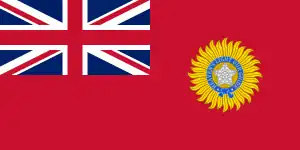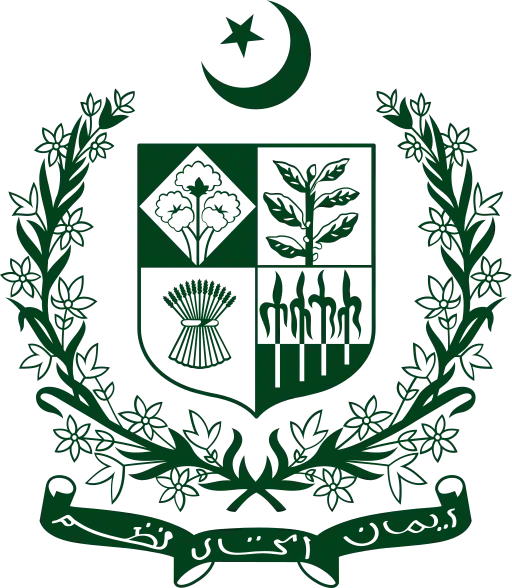| Sind | |||||||||||
|---|---|---|---|---|---|---|---|---|---|---|---|
| Province of British India (1936–1947) Province of the Dominion of Pakistan (1947–1955) | |||||||||||
| 1936–1955 | |||||||||||
 | |||||||||||
 Sind, highlighted in red on the map of British Raj | |||||||||||
| Capital | Karachi (1936-1947) Hyderabad (1947-1955) | ||||||||||
| Area | |||||||||||
• | 123,080 km2 (47,520 sq mi) | ||||||||||
| History | |||||||||||
• Formation of Sind Province | 1 April 1936 | ||||||||||
• Province of Pakistan | 14 August 1947 | ||||||||||
• Disestablished | 14 October 1955 | ||||||||||
| |||||||||||
 |
| This article is part of the series |
| Former administrative units of Pakistan |
|---|
Sind (sometimes called Scinde, Sindhi: سنڌ) was a province of British India from 1 April 1936 to 1947 and Dominion of Pakistan from 14 August 1947 to 14 October 1955. Under the British, it encompassed the current territorial limits excluding the princely state of Khairpur. Its capital was Karachi. After Pakistan's creation, the province lost the city of Karachi, as it became the capital of the newly created country. It became part of West Pakistan upon the creation of the One Unit Scheme.
Administrative divisions
On 1 April 1936 Sind division was separated from Bombay Presidency and established as a province.
At that time the Province's Administration division are listed below:
| Division | Districts in British Territory / Princely State | Map |
|---|---|---|
| Hyderabad Division | ||
| Total area, British Territory | 123,080 km2 (47,520 sq mi) | |
| Native States | ||
| Total area, Native States | 15,730 km2 (6,070 sq mi) | |
| Total area, Sind | 123,080 km2 (47,520 sq mi) |
Location
| Part of a series on |
| Sindhis |
|---|
 |
 Sindh portal |
The province was bordered by Karachi (within the Federal Capital Territory after 1948) and the princely states of Las Bela and Kalat on the west. To the north were the provinces of Baluchistan and West Punjab. The province bordered the princely state of Bahawalpur on the northeast and it enclosed on three sides the princely state of Khairpur. The Indian states of Rajasthan and Gujarat were beyond its borders to the east and south. On the southwest lay the Arabian Sea, with the Sind's coastline consisting entirely of river deltas, including the Indus River Delta up to Sind's border with the city of Karachi, now the capital of present-day Sindh.
History
Sindh was first settled by the Indus Valley civilization and Mohenjo-daro, as early as 1750 BC. It had Greek influence during its history after the expansion of the Macedonian Empire, and developed trade with surrounding regions. Several Sunni Muslim and Rajput kingdoms were set up there, beginning with the Rai dynasty and ending with the Arghuns. The Mughal Empire conquered Sindh under the rule of Akbar in the year 1591. Soon after the coming of European companies, in particular the East India Company, the Mughal hold on the area loosened, and in 1843 Sindh became part of the British India and its Bombay Presidency on 1 October 1848. Later it became Sindh province on 1 April 1935 under All India Act of 1935. Sind Province.
1936–1947
On 1 April 1936, Sind was separated from Bombay Presidency to get the status of a province and the provincial capital was settled in Karachi. Hyderabad division was formed on the place of Sind division.
1947–1955
Following a resolution in the Sindh Legislative Assembly about joining Pakistan, with the independence and Partition of India in August 1947 Sindh became part of Pakistan.
On 11 December 1954, the Sindh Legislative Assembly voted by 100 to 4 in favour of the One Unit policy announced by Prime Minister Chaudhry Mohammad Ali, and Sindh was merged into the new province of West Pakistan on 14 October 1955.[1]
Demographics
By the time of independence in 1947 Sindh had a Muslim majority for centuries but there were significant minorities of Hindus throughout the province. In 1947 due to communal tensions and partition two million Muslim refugees forced to flee to Pakistan while most Hindus fled to India.
The refugees from India were mostly Urdu speakers, and although the official language of Sindh was Sindhi, many schools in big cities of Sindh transitioned to Urdu language education.
Government
_map.gif)
The offices of Governor of Sindh and Premier (later Chief Minister) of Sindh were established in 1936 when Sindh became a province. This system continued until 1955 when Sindh was dissolved.
| Tenure | Governor of Sindh[2] |
|---|---|
| 1 April 1936 | Province of Sindh established |
| 1 April 1936 – 1 August 1938 | Sir Lancelot Graham (first time) |
| 1 August 1938 – 1 December 1938 | Joseph Garrett (acting) |
| 1 December 1938 – 1 April 1941 | Sir Lancelot Graham (2nd time) |
| 1 April 1941 – 15 January 1946 | Sir Hugh Dow |
| 15 January 1946 – 14 August 1947 | Sir Robert Francis Mudie |
| 14 August 1947 | Independence of Pakistan |
| 14 August 1947 – 4 October 1948 | Sir Ghulam Hussain Hidayatullah |
| 4 October 1948 – 19 November 1952 | Sheikh Din Muhammad |
| 19 November 1952 – 1 May 1953 | Mian Aminuddin |
| 1 May 1953 – 12 August 1953 | George Baxandall Constantine |
| 12 August 1953 – 23 June 1954 | Habib Ibrahim Rahmatullah |
| 23 June 1954 – 14 October 1955 | Iftikhar Hussain Khan |
| 14 October 1955 | Province of Sindh dissolved |
| Name of Premier (pre-partition) | Entered Office | Left Office | Political Party/Notes |
|---|---|---|---|
| Ghulam Hussain Hidayat Ullah (1st time) | 28 April 1937 | 23 March 1938 | Muslim People's Party |
| Allah Bux Soomro (1st time) | 23 March 1938 | 18 April 1940 | Ittehad Party |
| Mir Bandeh Ali Khan Talpur | 18 April 1940 | 7 March 1941 | All-India Muslim League |
| Allah Bux Soomro (2nd time) | 7 March 1941 | 14 October 1942 | Ittehad Party |
| Ghulam Hussain Hidayat Ullah (2nd time) | 14 October 1942 | 14 August 1947 | Muslim People's Party |
| Tenure | Chief Minister of Sind[2] | Political party |
|---|---|---|
| 14 August 1947 – 28 April 1948 | Mohammad Ayub Khuhro (1st time) | Pakistan Muslim League |
| 3 May 1948 – 4 February 1949 | Pir Illahi Bakhsh | Pakistan Muslim League |
| 18 February 1949 – 7 May 1950 | Yusuf Haroon | Non-partisan |
| 8 May 1950 – 24 March 1951 | Qazi Fazlullah Ubaidullah | Non-partisan |
| 25 March 1951 – 29 December 1951 | Mohammad Ayub Khuhro (2nd time) | Pakistan Muslim League |
| 29 December 1951 – 22 May 1953 | Governor's rule | |
| 22 May 1953 – 8 November 1954 | Pirzada Abdus Sattar | Pakistan Muslim League |
| 9 November 1954 – 14 October 1955 | Mohammad Ayub Khuhro (3rd time) | Pakistan Muslim League |
| 14 October 1955 | Province of Sindh dissolved | |
Elections
References
- ↑ Farhan Hanif Siddiqi, The Politics of Ethnicity in Pakistan (2012), p. 84
- 1 2 Ben Cahoon, WorldStatesmen.org. "Pakistan Provinces". Retrieved 3 October 2007.